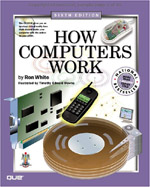 (Reprinted with permission from PC Magazine)
(Reprinted with permission from PC Magazine)
“Any sufficiently advanced technology is indistinguishable from magic,” said science fiction writer Arthur C. Clarke. So begins How Computers Work, Ron White’s illustrated journey inside the personal computers in which he demystifies the inner secrets of our desktop computers and their components, from disks to printers to system caches to networks.
The book’s contents are drawn from the “How It Works” column in PC/Computing (where White is an executive editor), which in turn pays homage to David Macaulay’s landmark The Way Things Work. Both tackle technical topics and explain them in ways that people without engineering degrees can understand.
You will not find hands-on guidance for repairs, upgrades, or troubleshooting sessions, but you will find White’s words backed up by some of the most elegantly simple, computer-generated technical drawings you could ever hope to find. Falling into the trap in which pictures become more important than the concepts they’re meant to represent is easy, but this book masterfully steers clear of that problem.
Much of the artwork depicts physical components and procedures in a simplified, schematic manner. For example, the eight-step representation of booting from a disk shows the roles played by BIOS (basic input-output system) chips, the CPU (central processing unit), different segments of the disk’s data storage area, and memory. Through a series of carefully labeled illustrations and brief captions, the process is broken down into easily digestible concepts.
Some concepts do not lend themselves readily to illustrations of real components, but White’s approach shifts to handle these with equal clarity. For example, the section on how data is written to and read from memory chips relies on a schematic of colored pipes, indicating the flow of electrical pulses. While the illustration does not look like the inside of a RAM (random access memory) chip, it does an excellent job of conveying how the chip operates.
As an enjoyable way to learn what makes your system tick, nothing comes close to How Computers Work. Browse through it for an entertaining and informative diversion, or work your way through from cover to cover for a thorough orientation. And when you’re finished, don’t hide it away on some remote shelf—leave it out on your coffee table where everyone can enjoy this beautiful book.
This unsigned review first appeared in PC Magazine, from which it is reprinted with permission.